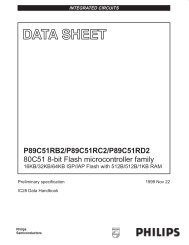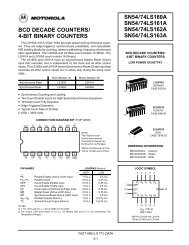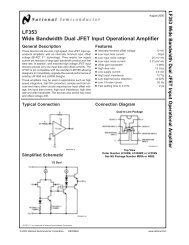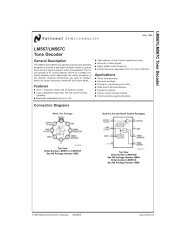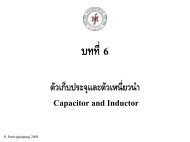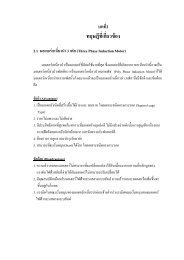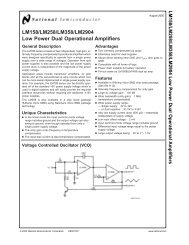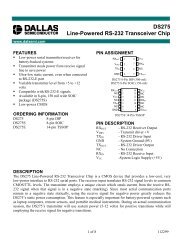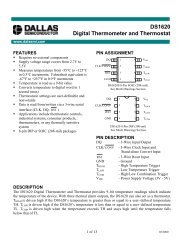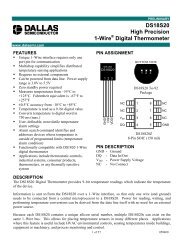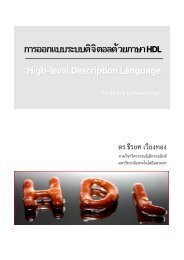tracking notch filter for electrocardiograph measurement
tracking notch filter for electrocardiograph measurement
tracking notch filter for electrocardiograph measurement
Create successful ePaper yourself
Turn your PDF publications into a flip-book with our unique Google optimized e-Paper software.
2.2.2 Quality factor. The band width of band stop <strong>filter</strong> isdependent on quality factor and center frequency as equation[2]. The quality factor is of 8 by which input logic Q6-Q0 ofintegrated circuit band stop <strong>filter</strong> is 1111000.electrode on right hand, and GND1 is connected to electrodeon left leg.ALISO175+Isolation barrierf oQ = [2]BWRGVoutwhere Q is quality factor and BW bandwidth of band stop<strong>filter</strong>.2.2. Frequency SynthesizerFunction of frequency synthesizer is multiplying inputfrequency, 40Hz to 70Hz, from noise frequency detector into6kHz to 10.5kHz as clock frequency <strong>for</strong> controlling switchedcapacitor.As mentioned, the multiplication ratio is then of 150times. Frequency synthesizer circuit consists of phase lockloop by which the minimum and maximum frequency ofvoltage control oscillator is as equation [3] and frequencydivider shown in Fig. 3.11fmin=and fmax=[3]R ( C + 32pF)R ( C + 32pF)R2Fnoi seC28330 pFR12 11 1CLK+ V cc25V.+Vcc2+V cc25V .5V.16 411 135 162 163O/ PLOAD RCO D/UEN Q0144PCAin1CLK Q15PCBin 312 MA X/CLK 14Q27C1BMIN 74LS191CD4518 6Q313PC2out+Vcc2P3 P2 P1 P06R6 R7 CTEN5V.C1ARES GND1M 100 K94 8 9 10 1 1512 VCOinR8 R9 R10 R117 8R2C2910 K 10K 10K 10 K2.2 uFGND211 MC14046R116 V.INH GND5 8Fig. 3. Frequency synthesizer.2.3. Noise Frequency DetectorInducing of electric field via signal cable is used to detectnoise frequency as input signal <strong>for</strong> voltage comparator.Hysteresis comparator shown in Fig. 4 is implemented asvoltage comparator by which ranging of transition voltage isassigned as equation [4]R2V = upper[ Vout(max)]R + R+R2and V = lower[ Vout(max)]R + R− [4]1 2VinR1Vout1 2ARVS1+ VS1- GND1 VS2+ VS2- GND2Fig. 5. Isolated instrument amplifier.3. Experiments and Results3.1. Band Stop FilterEach of the clock frequency of 7.5kHz, 8.25kHz and9.0kHz, respectively, is fed to band stop <strong>filter</strong>. Let input signalbe sinusoidal wave<strong>for</strong>m, whose amplitude and frequency are of1Vp-p and of 10Hz to 100Hz. Output signals are measured andrecorded and the frequency response is then plotted as Fig. 6.From Fig. 6, that is, the clock frequency of 7.5kHz, 8.25kHzand 9.0kHz correspond with center frequency of 50Hz, 55Hzand 60Hz, respectively.Fig. 6. Frequency response of band-stop <strong>filter</strong>.3.2. Frequency SynthesizerAs mentioned, let the multiplication ratio be 150 times. Theinput signal frequency from noise frequency detector as theclock frequency ranging from 40Hz to 70Hz fed into frequencysynthesizer. The output signal frequency is measured andrelation between the input and output signal frequency isplotted as shown in Fig. 7 by which data1 means the data fromexperiment and data2 means the data from calculation. We seethat the relation between the input and output signal frequencyis linear enough.R2Fig. 4. Hysteresis comparator.2.4. Isolated Instrument AmplifierTo amplify ECG wave<strong>for</strong>m having amplitude of 1mVapproximately, isolated instrument amplifier is applied andgain is of 1000 times. At here, we selected the integratedcircuit as ISO175 of Burr-Brown shown in Fig. 5. AL input isconnected to electrode on left hand, AR input is connected toFig. 7. Relation of input and output frequency.188


